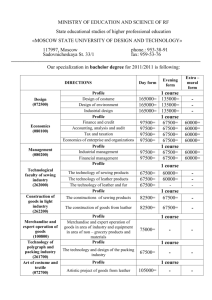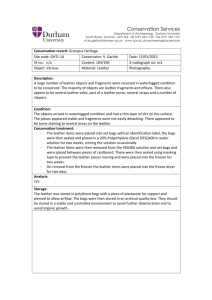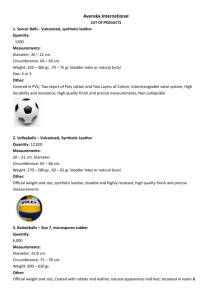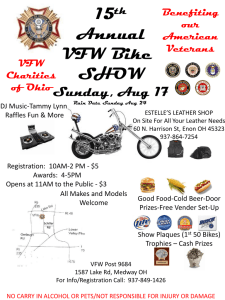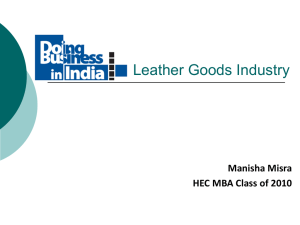1 d:\Wd85\Leather E.S.S. 7322/2011 Standards of Safety & Hygiene
advertisement
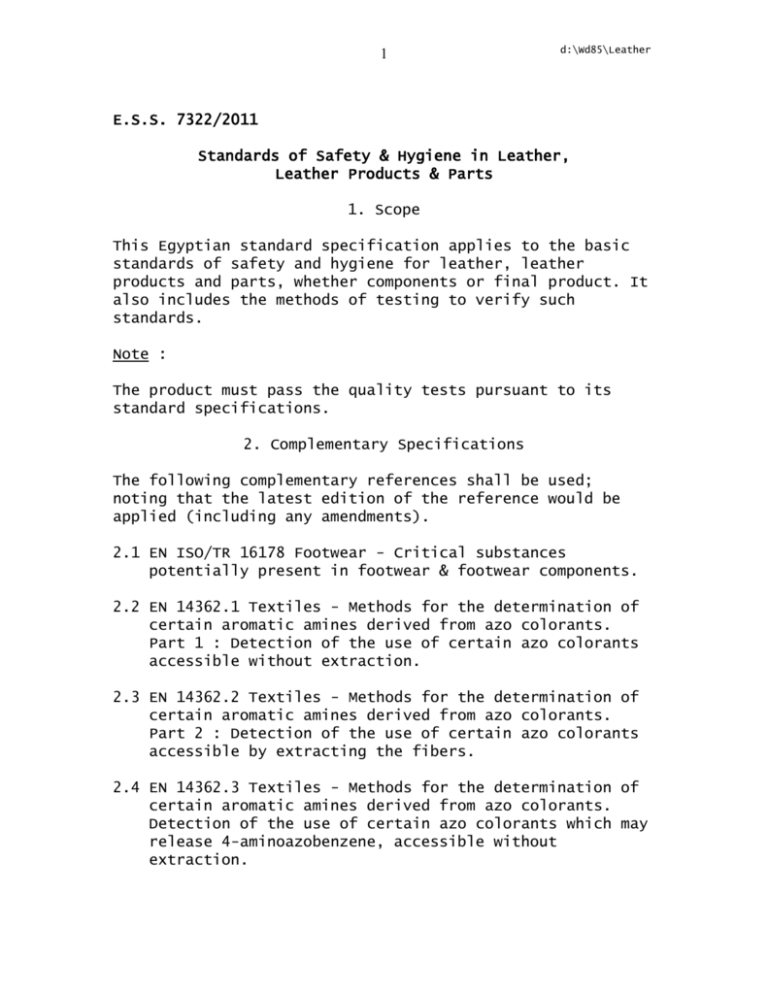
1 d:\Wd85\Leather E.S.S. 7322/2011 Standards of Safety & Hygiene in Leather, Leather Products & Parts 1. Scope This Egyptian standard specification applies to the basic standards of safety and hygiene for leather, leather products and parts, whether components or final product. It also includes the methods of testing to verify such standards. Note : The product must pass the quality tests pursuant to its standard specifications. 2. Complementary Specifications The following complementary references shall be used; noting that the latest edition of the reference would be applied (including any amendments). 2.1 EN ISO/TR 16178 Footwear - Critical substances potentially present in footwear & footwear components. 2.2 EN 14362.1 Textiles - Methods for the determination of certain aromatic amines derived from azo colorants. Part 1 : Detection of the use of certain azo colorants accessible without extraction. 2.3 EN 14362.2 Textiles - Methods for the determination of certain aromatic amines derived from azo colorants. Part 2 : Detection of the use of certain azo colorants accessible by extracting the fibers. 2.4 EN 14362.3 Textiles - Methods for the determination of certain aromatic amines derived from azo colorants. Detection of the use of certain azo colorants which may release 4-aminoazobenzene, accessible without extraction. 2 d:\Wd85\Leather 4. Standards of Safety & Hygiene in Leather, Leather Products & Parts 4.1 Table 1 includes standards of safety & hygiene in leather, leather products & parts Chemical Substances Azo – aryl amines Azo – aryl amines Raw Material Used Method of Testing Natural leather EN/ISO 17234-1 Natural leather EN/ISO 17234-2 - Synthetic leather : (polyamide – chloride fibers – polyaclyric) - Fabrics : (natural cellulose textile – natural protein textile) Printed textiles EN/ISO 14362-1 - Printed textiles - Synthetic leather : polyester EN/ISO 14362-2 - Synthetic leather : (polyester – polyamide – chloride fibers – polyaclyric) - Fabrics : (natural cellulose textile – natural protein textile - Printed textiles EN/ISO 14362-3 When 4-aminoazobenzene is suspected 1. Rate of azo dye Azo – aryl amines Azo – aryl amines Azo – aryl amines When 4-aminoazobenzene is suspected Limits Permitted 1. The azo dye list and the Azo dye mentioned in Appendix 1 shall not be used in skin direct touching leather and textile substances. 2. Regarding the azo dye list mentioned in Appendix 2, they shall not be used in concentrations higher than 0.1% by weight as substances or mixtures to color textile and leather goods. 3 d:\Wd85\Leather Chemical Substances Raw Material Used Method of Testing Limits Permitted 2. Cadmium (Cd) and compounds - (Coated leather) - Synthetic leather - Printed textile EN 1122 Not more than 0.01% to polymer weight 3. Rate of Chromium (VI) 4. Formaldehyde 5. Heavy substances (Sb-As-Ba-Cd-Cr-Pb-Hg-Sc) Natural leather EN ISO 17075 Not more than 3 mg/kg Natural & synthetic leather EN ISO 17226-1 Or ISO 17226-2 Not more than 150 ppm. Textile EN ISO 14184-1 Not more than 75 ppm. Children less than 36 months footwear (Size 26 & less) EN 71-3 & ISO 17072-1 Or ISO 17072-2 Element Limit Sb Not more than 60 mg/kg in substance As Not more than 25 mg/kg in substance Ba Not more than 1000 mg/kg in substance Cd Not more than 75 mg/kg in substance Cr Not more than 60 mg/kg in substance Pb Not more than 90 mg/kg in substance Hg Not more than 60 mg/kg in substance Sc Not more than 500 mg/kg in substance 4 Chemical Substances 6. Nickel directly touching skin 7. Content of pentachlorophenol (PCP), salts & esters 8. Rate of monomer in PVC d:\Wd85\Leather Raw Material Used Method of Testing Limits Permitted Solid metal parts EN 1811 CR 12471 EN 12472 If the nickel dash is more than 0.5 mg/cm2/week, it shall not be used in units that directly touch the skin for a long period of time Natural leather EN ISO 17070 1 ppm Natural substances used in footwear manufacturing (lumber – cork) EN/TR 14823 Not more than 5 ppm Fabrics (natural cellulose textile – natural protein textile) XP-G 08 015/2000 1 ppm - Natural leather (coated leather) - Synthetic leather (polyvinylchloride) ISO 6401 Not more than 1 ppm 5 Chemical Substances Raw Material Used In textile raw materials 9. Phthalates Children less than 36 months footwear (Size 26 & less) d:\Wd85\Leather Method of Testing Limits Permitted In synthetic leather (PE-TP)-EVApolyvinylchloriderubber-all kinds of polyurethane ISO 18856 Not more than 0.1% by weight - Coated leather - Synthetic leather (polyester-polyamidechloride fiberspolyaclyric) - Fabrics (natural cellulose textile-natural protein textile) - Printed textile EN 15777 Not more than 0.1% by weight - Coated leather - Synthetic leather (polyester-polyamidechloride fiberspolyaclyric-(PE-TP)EVApolyvinylchloriderubber-all kinds of polyurethane) - Fabrics (natural cellulose textilenatural protein textile) - Printed textile EN 71-10 Not more than 0.1% by weight & EN 71-11

